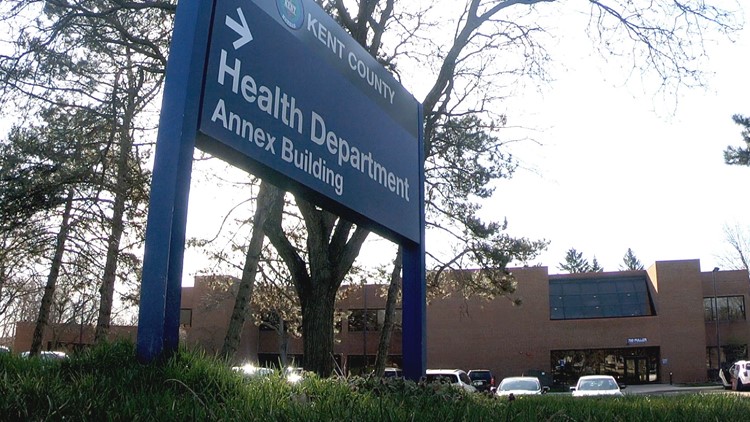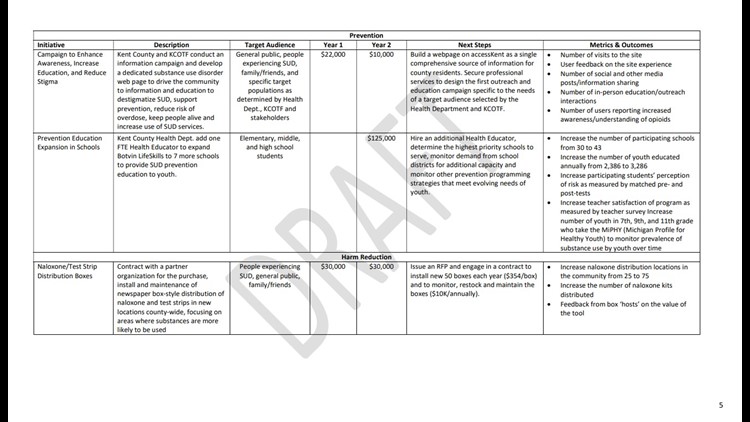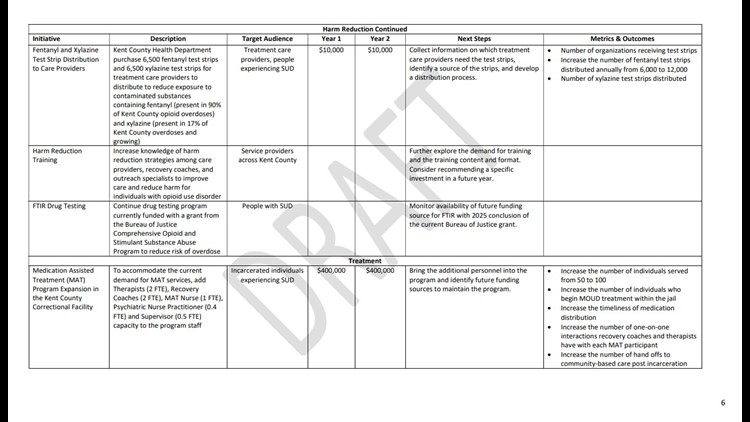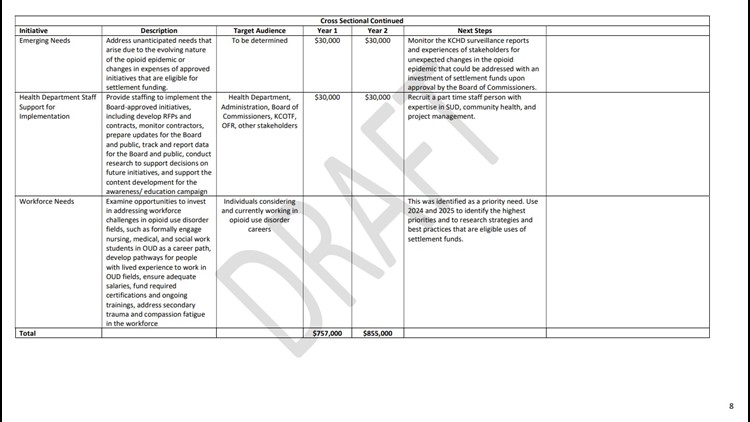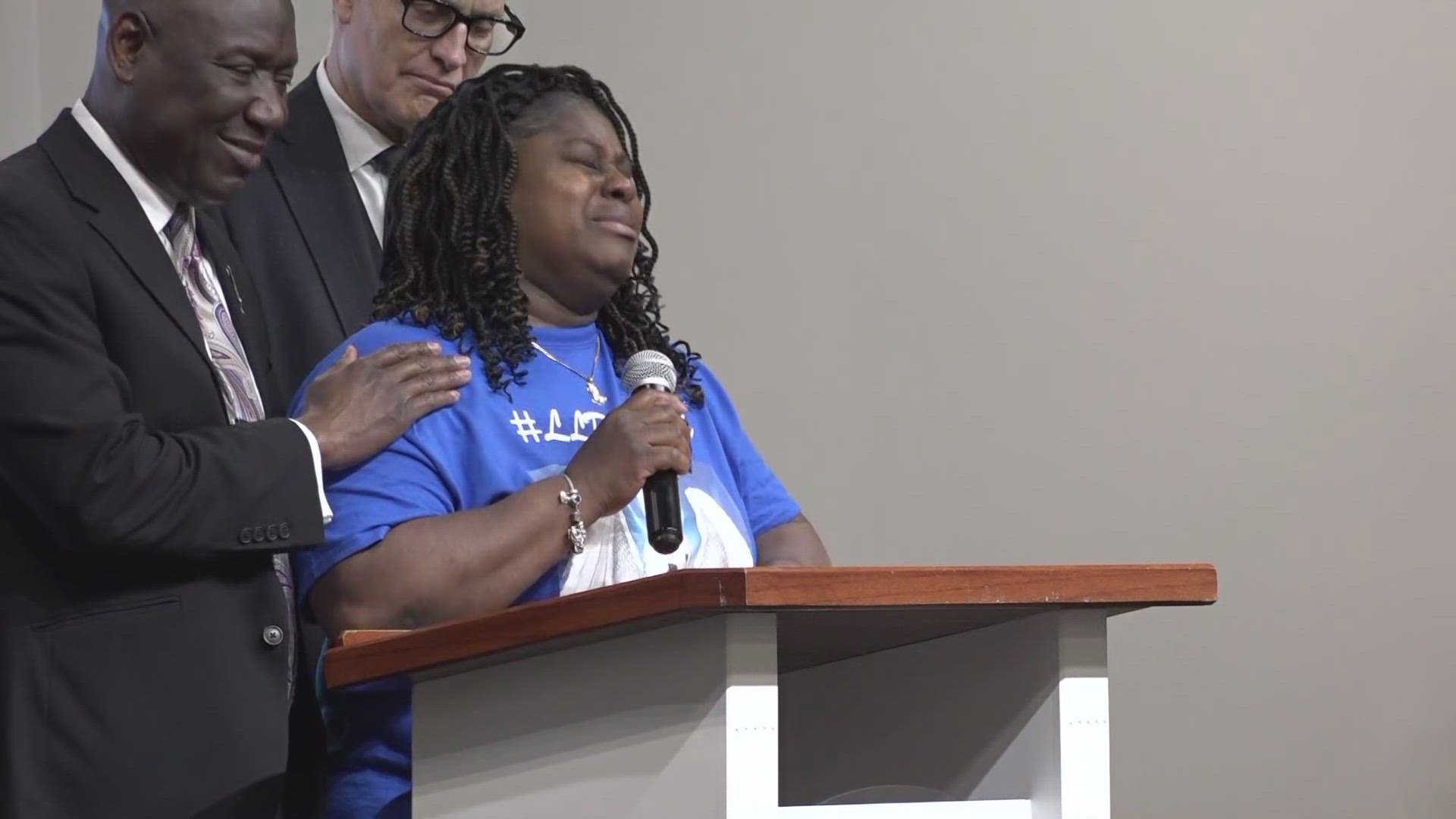KENT COUNTY, Mich. — Over 18 years, Michigan will receive nearly $1.6 billion from major opioid settlements.
Half will go to the state and half split amongst the 83 counties, depending on how large the counties are and how affected they have been by the epidemic. According to data estimates from the state, it ranges all the way from $173 in Union Charter Township to more than $70 million in Wayne County.
Those counties aren’t required to report how they’re spending the money.
Kent County told 13 ON YOUR SIDE they will, but not all local experts are convinced.
“It’s folks like the community members that were impacted that are saying like, ‘hey, my kid died from this. I want to make sure my neighbor doesn't deal with that. Can you please tell me that you're using the money well?’” said Jonathan Stoltman, director of the Opioid Policy Institute in Grand Rapids.
The money originates from a series of settlements, after Attorney General Dana Nessel joined a coalition with other states against opioid manufacturer Johnson & Johnson and pharmaceutical Cardinal Health, McKesson and AmerisourceBergen.
Epidemiologist Rachel Jantz leads the Kent County Opioid Task Force, which has been at the ready long before these settlements were even in question.
“Because we already have that structure in place, that's kind of how we've modeled the opioid settlement investment as well, trying to align the dollars with the work that's already going on in Kent County, but also filling in some of the gaps that we haven't previously been able to touch on because we didn't have a dedicated funding source,” Jantz said.
It’s been about one year since Kent County has started seeing those funds roll in, which will eventually total more than $18 million. However, they haven’t spent any of the $1.6 million currently sitting in a bank account.
The 100+ person task force includes an extensive list of experts in fields like law enforcement, pharmacy, academia, education and health systems. They’ve been spending the past couple of years planning how to use the first two years of funding.
“It requires some careful planning,” said Jenny James, Deputy County Administrator. “It’s not a pot of money upfront that we can do as we please. There are specific uses and on a specific timeline.”
Those specific uses are outlined in Exhibit E, a national outline of how these funds can be used.
Stoltman, a member of the task force, worries that despite these specific uses there isn’t enough transparency in Kent County’s process, even internally.
“All of that process is still like completely opaque,” Stoltman said. “Even though I have like a little bit of insight to it, I can't figure it out.”
Stoltman isn’t alone in his concerns.
Ivan Diaz, a Democratic Kent County Commissioner for District 20, says he’s been asking for the plan and hadn’t been able to get it.
“Michigan is, has historically been one of the worst when it comes to transparency, it's no surprise to me that that leaks down to the local units of government,” Diaz said.
13 ON YOUR SIDE reached out to the Board of Commissioners and Health Department after hearing this. They responded the same day we interviewed Diaz with the following draft.
Kent County opioid settlement spending plan for year 1 and 2
Stan Stek, Chair of the Kent County Board of Commissioners, believes there is transparency.
“I think there's transparency,” Stek said. “He (Diaz) might be looking for this final report, and that's fairly recent. In fact, it's still in draft form.”
Jantz explained why putting together a draft like this takes time.
“Being transparent with our community, making sure we're talking to a diverse array of partners, not throwing all of our investment into one bucket, and spreading them out across the continuum of the opioid epidemic,” Jantz said.
These buckets are echoed by other experts 13 ON YOUR SIDE conferred with: Prevention, harm reduction, treatment and recovery.
Kent County is spending half of their first two years’ budget, adding up to $800,000, on just treatment at the correctional facility.
“That's not to say like, prevention doesn't matter. But prevention is a pretty long game,” Stoltman said. “So if you're thinking how to allocate resources in these first couple of years, it's helping people survive that are at risk right now.”
The plan says this $400,000 each year would allow them to add more staff to the facility, including two therapists, two recovery coaches, a MAT nurse, a psychiatric nurse practitioner and a supervisor.
As a member of the task force, Stoltman has had access to this since earlier this year. The task force voted on where they’d like to see the money spent. However, he says this isn’t entirely what they voted for, and there isn't a way to check.
"I have not seen the the final number of votes, and I also haven't seen the decision-making on what the stakeholders voted on and prioritized and what wasn't included in the survey and why," Stoltman said.
While support for the correctional facility was one of the options that received support, he said the results of the survey were never made public.
"It's not like the only people who need treatment are in carceral settings. There's a lot of people in our general community that can't find treatment, especially evidence-based treatment," Stoltman said. "If you make it mostly available in carceral settings, this kind of perversely incentivizes doing that law enforcement approach."
Stoltman and some other members of the task force organized under the KCOTF Intervention Committee to send a letter to the Health Department, requesting more transparency, in July 2023.
13 ON YOUR SIDE obtained the following letter from members of that committee.
It reads, in part: "We are concerned that Kent County Health Department (KCHD) and Kent County Commission (KCC) have not created a specific funding pathway for harm reduction services in line with the needs of community members who use these services. It is an ethical imperative that each dollar of this settlement money be spent well and spent to rectify the harms caused by the defendants."
The letter goes on to ask for the task force's voting to be made public, more funding for harm reduction, and a needs assessment prior to any funding disbursement.
The department responded with the following letter, signed by Health Officer Adam London. It acknowledges their concerns for transparency and that there is room for improvement in the process.
London sat down with 13 ON YOUR SIDE. He said he was not shocked to receive the initial letter and that it reflects the passion of the task force.
"We're doing much better than so many other places, because of them and their passion, so don't let that go. But please remember, we're on the same team here," London said.
He does believe that the results of the vote are reflected by this plan.
"I know that having recovered coaches in the community was I think, the highest priority. I think the second highest priority was making sure that medically assisted treatment continued at the correctional facility," London said. "When you take this first year's funding and try to divide it by all the good ideas, there's just, you really butt up against the limitations of the dollars pretty quickly."
He also believes that strides have been made since last summer toward more transparency, and that a needs assessment is possible in the future.
The next step for Kent County is to get this draft in front of the Board of Commissioners for approval, likely at their May 21 meeting.
“It'll be available for anyone to review and to advise, to call their Commissioner if they like it, if they don't like it,” Stek said.
Though this plan is for the first and second years of funding, it won't be finished until 2040.
“It is such a large amount of money that we can have this transformative change,” Stoltman said. “Only if we make that effort.”
You can find exactly how much your county or state is spending by going to the state’s website and clicking on “Opioid Settlement Payment Estimator.” That will download a spreadsheet with their current estimates.
►Make it easy to keep up to date with more stories like this. Download the 13 ON YOUR SIDE app now.
Have a news tip? Email news@13onyourside.com, visit our Facebook page or Twitter. Subscribe to our YouTube channel.
Watch 13 ON YOUR SIDE for free on Roku, Amazon Fire TV Stick, and on your phone.


